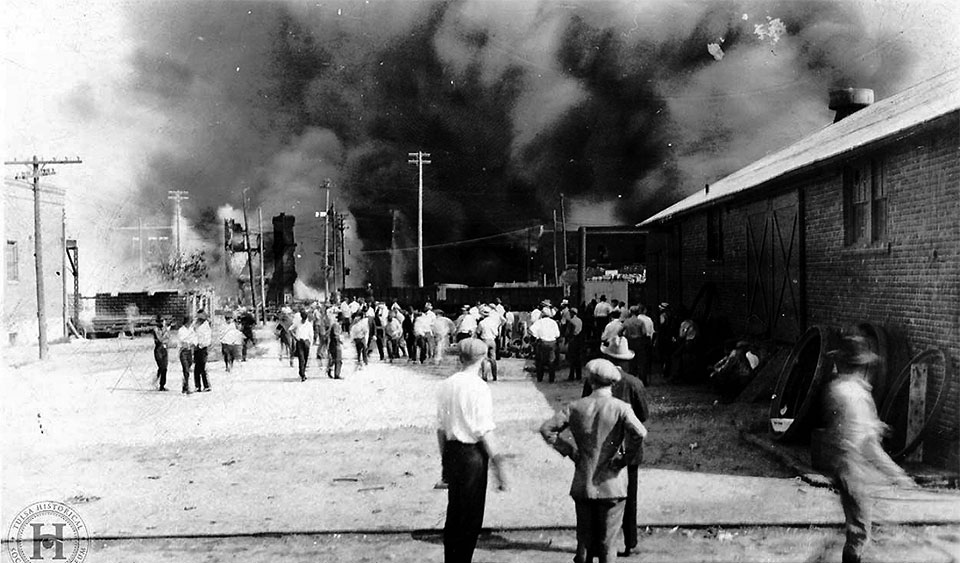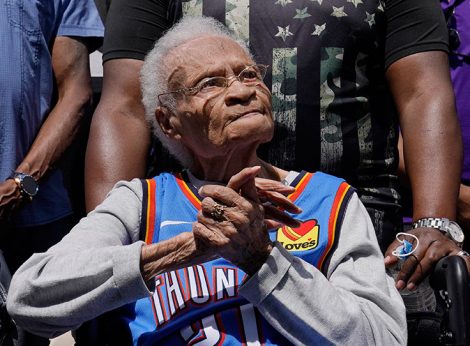
WASHINGTON—Viola Fletcher, Leslie Evelyn Benningfield Randle, and Hughes Van Ellis live with continuing painful memories of the night of May 31-June 1, 1921.
They were children then—“Mother” Fletcher, now 107, had just turned seven, Randle was six, and Van Ellis was an infant—in the well-off vibrant Greenwood community of more than 10,000 Black Americans in Tulsa, Okla.
And then disaster, a white massacre of the Black residents of Greenwood, hit.
“The neighborhood I fell asleep in that night was rich, not just in terms of wealth, but in culture, community, and heritage. My family had a beautiful home. We had great neighbors, and I had friends to play with. I felt safe. I had everything a child could need. I had a bright future ahead of me. Greenwood could have given me the chance to truly make it in this country,” Fletcher told Congress in mid-May 2021.
“Within a few hours, all of that was gone. The night of the Massacre I was woken up by my family. My parents and five siblings were there. I was told we had to leave. And that was it.
“I will never forget the violence of the white mob when we left our house. I still see Black men being shot, and Black bodies lying in the street. I still smell smoke and see fire. I still see Black businesses being burned. I still hear airplanes flying overhead.” The planes were bombing Greenwood, another witness, an historian and descendant of survivors, said.
“I hear the screams. I live through the Massacre every day,” Fletcher said.
Fletcher and her brother, Van Ellis—a World War II veteran—and Randle are the last three survivors of that massacre of Black Tulsans by a mob of at least 5,000 whites. A state investigation early in the 21st century showed white Oklahoma and Tulsa officials aided and abetted it. It utterly destroyed the 40-square-block community and left continuing racial economic and social injustice in Tulsa.
The same pattern had occurred elsewhere nationwide after the end of the Civil War. Notable evidence: 4,075 known lynchings nationwide from 1877-1950, white-on-Black multiple murders in New Orleans (1866), East St. Louis (1917), Chicago, Ill. (1919), Springfield, Ill. (1920), and Detroit (1943).
In Detroit, 25 African Americans died over three days as white racists rioted against housing for Black workers who had migrated north to work in auto factories, turning out tanks for World War II. The East St. Louis murders on May 28 and for three days in July 2017 were by white racists angry over Blacks “taking” jobs in World War I-era factories. Between 40 and 250 Black people were killed.
But Tulsa was the worst.
At least 300 Black people died, and the other 10,000-plus were left homeless, forced to flee, or interned in camps for “protection” for weeks afterwards, white Oklahoma officials said. The homes, businesses, and churches of what was a thriving “Black Wall Street” known nationwide burned to the ground. Property losses totaled $200 million in today’s dollars. Tulsa feels continuing after-effects, witnesses said.
Lives with promising futures, including Fletcher’s and Randle’s, were left in poverty for literally a century, their educations trashed, forced to take menial jobs, barely scraping by. The two women told lawmakers they’re left with 100 years of nightmares.
Van Ellis fought overseas in World War II and came home to find, like other Black men, not just that segregation and racism continued on the local level but that many Black veterans like him couldn’t get benefits of the G.I. Bill of Rights, he told lawmakers. The reason left unsaid: Congressional racism.
“We were made refugees in our own country,” Van Ellis said of those fleeing Tulsa.
The survivors and their descendants carried the full story in their hearts and memories. But Tulsa was otherwise buried from U.S. history. Indeed, when mentioned at all in later decades, the Tulsa massacre was misnamed “a race riot,” implicitly lumping it with other, later, disorders.
And the injustices continue, the three survivors and four other witnesses told the House Judiciary Constitution and Civil Liberties Subcommittee on May 19. Greenwood has been paved over by urban renewal. While archeologists in Tulsa now prospect for graves of the victims, white Tulsa profits off the increased publicity.
Meanwhile, northern Tulsa, now the city’s Black community, is a food desert and poor, said Dr. Tiffany Crutcher, great-granddaughter of another survivor—and twin sister of an unarmed Tulsa African American shot to death, her brother Terence, by a white cop in September 2016. A jury acquitted the cop of manslaughter.
The survivors tried suing the city, county, and state in later years, but courts tossed their cases out. The statute of limitations had expired. They asked Congress more than a decade ago for legislation to waive that bar. Rep. Jerrold Nadler, D-N.Y., who then chaired the Constitution subcommittee and now chairs the full committee, agreed, but Congress didn’t.
On May 19, they tried again, this time for justice and, said Crutcher, reparations.
Faced with indifference or worse from the right-wing Republicans who now run Oklahoma, plus their business backers in the Tulsa Chamber of Commerce, the survivors and their allies turned to Congress for recognition of that real history. Crutcher also demanded an end to immunity for police murders of unarmed people.
Speaking at the hearing, Nadler, too, advocated reparations for Tulsa Massacre survivors and descendants. He called the massacre “an act of ethnic cleansing” on U.S. soil. An end to police immunity for shootings of unarmed unresisting people is a key provision in House-passed criminal justice legislation. But cop groups and the Senate’s Republicans vociferously oppose it.
Judiciary Republicans weren’t as crass on May 19. They knew better than to openly oppose the witnesses. Even their committee leader, Rep. Jim Jordan, R-Ohio, a vitriolic defender of racist former GOP Oval Office occupant Donald Trump, acknowledged the massacre.
He then pivoted to praising what he called racial progress since 1921, particularly citing low Black unemployment rates under Trump. Jordan was silent about reparations and police immunity.
The victims are left with the pain. Listen to Randle, at the panel’s hearing, as part of the entire hearing:
“One hundred years ago, in 1921, I was a 6-year-old child,” she testified. “I was blessed to live with my grandmother in a beautiful Black community in Tulsa Okla., called Greenwood. I was lucky. I had a home. I had toys. I didn’t have any fears as a young child, and I felt very safe. My community was beautiful and was filled with happy and successful Black people. Then everything changed.
“It was like a war. White men with guns came and destroyed my community. We couldn’t understand why. What did we do to them? We didn’t understand. We were just living. But they came, and they destroyed everything.
“They burned houses and businesses. They just took what they wanted out of the buildings then they burned them. They murdered people. We were told they just dumped the dead bodies into the river. I remember running outside of our house. I ran past dead bodies. It wasn’t a pretty sight. I still see it today in my mind, 100 years later.

“The white people who did this to us were filled with so much hate. It is disgusting they hate us for no reason except that we are Black people.
“Most of the people who committed these acts are dead now…. But just because these men are probably dead, the city and county of Tulsa, the state of Oklahoma, and the Tulsa Chamber are still responsible for making it right. The city and county caused this to happen to us. The state allowed this happen to us. They didn’t protect us.”
Fletcher had one more linkage to make. The Tulsa Massacre was swept under history’s rug after it occurred, she said. Now, she warned, some politicians—she didn’t name names—are trying to sweep history under the rug again.
“I saw what happened here on Jan. 6th this year. It broke my heart. It reminded me of what happened 100 years ago. And now, I hear some of you on TV saying it didn’t happen, like we didn’t see it with our own eyes. It happened on live TV. 100 years ago, there was no TV, but you have me here right now. You see Mother Randle. You see my brother, Hughes Van Ellis. We lived this history. We can’t ignore it. It lives with us.
“We lost everything that day. Our homes. Our churches. Our newspapers. Our theaters. Our lives. Greenwood represented the best of what was possible for Black people in America, and for all people. No one cared about us for almost 100 years. We, and our history, have been forgotten, washed away. This Congress must recognize us, and our history,” Fletcher concluded.










